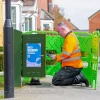Vodafone UK and Google Boost 5G Upload Speeds for Pixel Users via MIMO and ULCA

Vodafone UK has announced that they’ve worked with Google to bring MIMO (Multiple Input, Multiple Output) support to their Pixel 8 Pro and new Pixel 9, 9 Pro, 9 Pro XL, and 9 Fold phones when on the mobile operator’s new 5G Standalone (broadband) network, which has helped to boost upload speeds. But Google users won’t be the only ones to benefit.
Vodafone has already made 5G SA technology (i.e. their end-to-end pure 5G network) available in the “busy areas” of 23 cities and hundreds of other locations across the UK, although it’s currently only accessible to customers with supporting devices on their Ultra plans.
However, until recently, owners of Google’s Pixel 8 and 9 Smartphones haven’t been able to take full advantage of some of the new network’s features (when covered by it). But that started to change in June 2024, when MIMO technology was introduced to Google’s phones, resulting in faster uploads, and enhanced Uplink Carrier Aggregation (ULCA – using several radio bands at once) was also added for increased download speeds.
Advertisement
Vodafone has since doubled the number of antennas communicating with Google’s phones, improving their mobile broadband performance and the reliability of the connection. This is complemented by the new ULCA combinations available on their 5G Ultra network, allowing the simultaneous aggregation of four spectrum bands (i.e. more spectrum capacity and greater efficiency of the transmission itself).
Andrea Dona, Chief Network Officer, Vodafone UK, said:
“By looking at the data, we can clearly see customer behaviour changing as more of our lives become digital. In previous years, the digital highway was a one-way street, with consumers downloading significantly more data than uploading, but it is starting to balance out now. We must recognise this customer trend and adapt our network as a result.”
Michiel van Eldik, VP, Devices & Services Partnerships, Google EMEA, said:
“We want our customers to have the freedom to share their experiences seamlessly and in the highest quality possible. That’s why we’re thrilled to partner with Vodafone on network advancements that make this a reality. Whether it’s live-streaming a concert or sharing a 4K video with loved ones, we’re committed to providing the best possible mobile experience.”
We should point out that MIMO technology, which is an enhancement in which multiple antennas are used at both the source (mobile mast) and the destination (the user device), is nothing new to wireless networks. But sometimes extra work is required to ensure that these enhancements are properly supported with each new generation of technology and device. It’s a similar story for ULCA, which was also part of the 4G Advanced (LTE-A) spec.
The good news is that Vodafone now intends for both of these capabilities, under their 5G SA network, to be “made available on other devices in the future“. But at the time of writing, we don’t currently know which devices that will include or when the enhancements will go live for them. Sadly, Vodafone did not provide any benchmarks to show the before and after impact of these changes, which would have been interesting.
Mark is a professional technology writer, IT consultant and computer engineer from Dorset (England), he also founded ISPreview in 1999 and enjoys analysing the latest telecoms and broadband developments. Find me on X (Twitter), Mastodon, Facebook, BlueSky, Threads.net and Linkedin.






















































UCLA is one of those more interesting features on 5G. It can potentially address the fact that masts are able to blast out signal at high power, but phones are much more constrained.
You may be able to cling onto a mast in poor or congested signal conditions by using a high band download, and a low band upload, meaning it’s more efficient for the phone.
There’s going to be a slow trickle of 5G features that will make it better over time which is nice, but also kinda counters the narrative the networks have been spinning that it’s a revolution on day 1
Do you know if EE will be introducing the same?
EE already does it, this technology isn’t new.
Reality is that Telco’s both manufacturers and service suppliers are constantly about upselling things people have already brought.
I think its becoming quite disgusting that the blame game constantly gets put on various things but its never called out when companies intentionally delay the progression of the technologies which essentially falls down to degraded services for most, all in the name of exclusivity deals to upsell premium plans and partner devices.
We have one provider that has limited 5GSA to certain plans/devices (all of which are premium) and then we have another provider that has simply just switched it on for all to connect but has stipulated a supported device list.
I’m not sure this is relevant.
Regardless, 5G is not a singular thing. Features are added at each version, just like with 4G, of which there were 7 versions.
Each version adds optional features that may be adopted by some devices on some networks in some circumstances, dependent on the value.
What a bizarre world of mobile. Imagine if the headline was “Vodafone introduces 1.6gbps tier for Macbook Pros with the M4 chip”. We’d all be wondering why this has to be exclusive to only one category of computer.
Those Google phones have a Samsung modem, most other phones use Qualcomm. They’re possibly the only phones that support this at the moment.
I already find Vodafone 5G SA on my Pixel 9 Pro is fairly non existent when compared with it on my unsupported Xiaomi 14 Ultra. It just doesn’t show up at all when I’m at home on my Pixel, but it’s there with my Xiaomi. Maybe these tweaks will help.
I think that’s probably related to carrier profiles and area. My mum currently uses a Pixel 8 Pro and she ported to Vodafone on the 11th of December and she’s had 5G Ultra as soon as she was ported over.
It’s been pretty good in fact, signal strength displays as worse than on 4G but I think Vodafone has deliberately changed it to display as lower than it actually is (e.g. -95dBm on n78 shows up as 2 or 3 bars, can’t remember which one when it would be 4 bars on 4G).
I’m not sure what Vodafone has configured for 5G Ultra signal strength, but for 4G, it usually is -98dBm or better for 4 bars, -108dBm or better for 3, -118dBm or better for 2, -128dBm or better for 1 and anything below -128dBm is 0 bars.